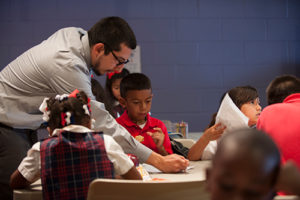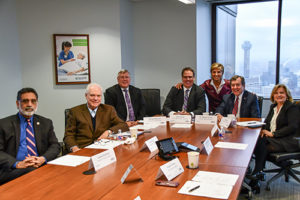DFW higher education reflects the region’s economic growth and diversity
When roughly 380,000 postsecondary students return to school every fall in DFW, it’s no front-page news, as it might be in Austin or Columbus, Ohio. Make no mistake — Dallas-Fort Worth is no typical college town; yet, aspiring engineers, doctors, architects and scientists are flocking here because of our diverse higher education institutions and the job opportunities that follow.

Nearly 70+ institutions are spread across more than 200 cities that comprise the DFW Region.
“DFW has among the most diverse, growing economies in the United States,” says Dale Petroskey, president and CEO of the Dallas Regional Chamber, citing the most recent Moody’s Diversity Index. “The region’s higher education scene reflects that.”
That diversity fuels opportunities that might not happen in other metros across the United States.
The typical higher education path of a DFW Region student doesn’t travel from the classroom to a standing desk or to a product team. Long before many graduate, students in DFW are engaging in design thinking, pitching their ideas for new startups and collaborating with major companies on real-world problems.
Where else would students collaborate with the Dallas Cowboys while earning sports-management MBAs? Enroll in a law school geared toward helping secure legal services for all socioeconomic statuses? Receive an anthropology degree and move on to help give Amazon’s Alexa her personality?
Those experiences lead to jobs. Nearly three-fourths of these students will stay and start careers here, providing the talent that propels Amazon, State Farm, courtrooms, health care facilities and other institutions that require the skills of advanced degree holders.
Growing Population, Growing Enrollments
More than 7.5 million people live in the DFW Region, which is increasing at a rate of about 361 people per day.
That population increase partially explains the growth in higher education: Over the past 10 years, enrollment increased, on average, more than 3% annually, according to the most recent data from Integrated Postsecondary Education Data System. That’s quadruple the national 0.8% annual growth rate.
Likely fueling the growth are both the quality of educational institutions and corporate relocations/expansions to the DFW Region, says a report from the Federal Reserve Bank of Dallas.
“The area still attracts business and financial services companies, which have reached a critical mass and can draw on a network of necessary support services,” writes the Federal Reserve Bank of Dallas in its study, At the Heart of Texas. “Overall growth is buoyed by a well-educated population, a competitive cost structure and the U.S. economy’s strength.”
Collision-Driven Education System
Because universities, colleges and schools are located in population centers across DFW, collisions with hungry and innovative organizations in their orbits are almost inevitable.
It explains how economist and SMU data analyst Tom Fomby can bump into a UT Southwestern faculty member at a university mixer and then collaborate to develop a way to predict and prevent West Nile Virus outbreaks. It explains how a couple of NASA representatives might land at Texas Woman’s University (TWU) one day and suggest that they consider competing in the Texas Space Grant Consortium (six TWU students did and walked away with first prize, on their first try). It explains how, 50 years ago, Texas Instruments could launch the precursor to the University of Texas at Dallas to ensure a steady flow of educated, creative professionals.
These collisions — intended or unintended — are what helped make DFW what it is today.
Working for the Workforce
Just as the visionaries of yesterday, who pushed to create what are now the region’s three Carnegie-classified tier 1 research institutions, today’s leaders are looking toward the future, looking at how they can meet the needs of future students and employers.
A new collaborative hub is being created, further uniting universities with employers to give prospective workers the skills they need.
In spring 2019, Dallas County voters approved the sale of a $1.1 billion bond, about half of which will build Dallas College’s state-of-the-art education and innovation hub in downtown Dallas.
This follows the 2017 launch of the Dallas County Promise, which guarantees a postsecondary degree at no cost to high school students across 11 public school districts in the county.
Collin College, meanwhile, is slated to open its $179 million, 340,000-square-foot Collin College Technical Campus in fall 2020. That facility will serve more than 4,000 students and will offer degrees and certificates ranging from architecture and construction to engineering technology and manufacturing.
West of Dallas, Tarrant County voters passed an $825 million bond proposal to improve, renovate and enhance workforce technology across the six Tarrant County College campuses.
The planned enhancements align with education and training that match local jobs, career opportunities and interests of the regional economy.
Creating Something Bigger, Together
“The theoretical nature of higher education often creates natural partnerships with cutting-edge industries,” says Dr. Victor Fishman, executive director of the Texas Research Alliance. “The inverse is true as well.”
Adds Fishman: “The translation into curriculum of research at the frontiers of science, technology, engineering, math and management makes higher education institutions ideal partners for problem-solving across all industries.”
Because the DFW Region is no typical college town or company town — where no single institution dominates the economy —entrepreneurs, business leaders and academics have connected organically to create something bigger.
In the pages that follow, we highlight how the region’s individual institutions of higher education combine to attract the highest-quality students and companies, allowing the region to compete at a global level.
This article is part of the 2020 Higher Education Review Magazine.









 As each legislative session begins, the flurry of visitors flooding the capitol advocating for change, opportunity and new policies is unmistakable. DFW higher education institutions are no stranger to this biannual tradition, employing institutional government relations staff and advisors to work with state legislators on higher education funding, research and policy improvements. It became clear, through the UCEO Council, that while each institution’s voice was valued in the capitol, the voice of higher education in DFW would be stronger combined. Initially, the work began as simply drafting a list of priorities that regional higher education and business leaders agreed upon for each session and has grown into a working coalition advocating in Austin under one unified voice. This strategy has paid off for DFW. Their influence in Austin has grown. They have seen improved transfer and articulation policies, increased funding for research and funding for capital building projects on campuses.
As each legislative session begins, the flurry of visitors flooding the capitol advocating for change, opportunity and new policies is unmistakable. DFW higher education institutions are no stranger to this biannual tradition, employing institutional government relations staff and advisors to work with state legislators on higher education funding, research and policy improvements. It became clear, through the UCEO Council, that while each institution’s voice was valued in the capitol, the voice of higher education in DFW would be stronger combined. Initially, the work began as simply drafting a list of priorities that regional higher education and business leaders agreed upon for each session and has grown into a working coalition advocating in Austin under one unified voice. This strategy has paid off for DFW. Their influence in Austin has grown. They have seen improved transfer and articulation policies, increased funding for research and funding for capital building projects on campuses.


